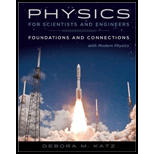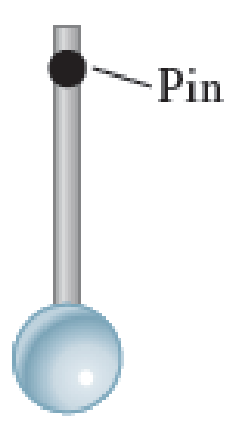
Concept explainers
What Is Static Equilibrium?
Problems 1–3 are grouped.
1. C A ball is attached to a strong, lightweight rod (Fig. P14.1). The rod is supported by a horizontal pin near the top. The ball is at rest. Is the ball in static equilibrium? If not, why not? If so, which type of equilibrium is it—stable, unstable, or neutral? Hint: What would happen if you displaced the ball slightly?

FIGURE P14.1
Whether the ball is in static equilibrium and if so the type of equilibrium in which the ball is present.
Answer to Problem 1PQ
The ball is in static equilibrium and it is stable equilibrium.
Explanation of Solution
Equilibrium is a special case of motion in which an object’s translational momentum and angular momentum are both constant. Static equilibrium is a special case in which the object’s translational momentum and angular momentum are zero. This also implies that for an object to be in static equilibrium, the total force and the total torque acting on the object must be zero. There are three types of static equilibrium namely stable static equilibrium, unstable static equilibrium and neutral static equilibrium. If an object returns to its equilibrium position after being released, it will be in stable equilibrium. If an object moves farther away from the equilibrium position after being released, it will be in unstable equilibrium. If an object is moved and released from a new position and does not move toward or away from its equilibrium position, then the object is in neutral equilibrium.
It is given that the ball in the figure is at rest so that it has no acceleration. This implies the net force and the torque acting on the ball are zero and the ball must be in static equilibrium. If the ball is displaced slightly, it will return to or pass through the equilibrium position. According to the definition, it is stable equilibrium.
Conclusion:
Thus, the ball is in stable static equilibrium since the net force and the torque acting on it is zero and it returns to its equilibrium position when it is displaced slightly.
Want to see more full solutions like this?
Chapter 14 Solutions
Physics For Scientists And Engineers: Foundations And Connections, Extended Version With Modern Physics
- Two objects get pushed by the same magnitude of force. One object is 10x more massive. How does the rate of change of momentum for the more massive object compare with the less massive one? Please be able to explain why in terms of a quantitative statement found in the chapter.arrow_forwardA box is dropped on a level conveyor belt that is moving at 4.5 m/s in the +x direction in a shipping facility. The box/belt friction coefficient is 0.15. For what duration will the box slide on the belt? In which direction does the friction force act on the box? How far will the box have moved horizontally by the time it stops sliding along the belt?arrow_forwardNo chatgpt pls will upvotearrow_forward
- No chatgpt pls will upvotearrow_forwardA toy car speeds up at 1.0 m/s2 while rolling down a ramp, and slows down at a rate of 2.0 m/s2 while rolling up the same ramp. What is the slope of the ramp in degrees? Grade in %? The friction coefficient?arrow_forwardPlz solution should be complete No chatgpt pls will upvote .arrow_forward
- A box with friction coefficient of 0.2 rests on a 12 foot long plank of wood. How high (in feet) must one side of the plank be lifted in order for the box to begin to slide?arrow_forwardWhat is a good general rule to follow in order to find the best choice of coordinate system to solve a dynamics problem?arrow_forwardWhat is the meaning of a first order approximation?arrow_forward
 Physics for Scientists and Engineers: Foundations...PhysicsISBN:9781133939146Author:Katz, Debora M.Publisher:Cengage Learning
Physics for Scientists and Engineers: Foundations...PhysicsISBN:9781133939146Author:Katz, Debora M.Publisher:Cengage Learning Physics for Scientists and EngineersPhysicsISBN:9781337553278Author:Raymond A. Serway, John W. JewettPublisher:Cengage Learning
Physics for Scientists and EngineersPhysicsISBN:9781337553278Author:Raymond A. Serway, John W. JewettPublisher:Cengage Learning Physics for Scientists and Engineers with Modern ...PhysicsISBN:9781337553292Author:Raymond A. Serway, John W. JewettPublisher:Cengage Learning
Physics for Scientists and Engineers with Modern ...PhysicsISBN:9781337553292Author:Raymond A. Serway, John W. JewettPublisher:Cengage Learning College PhysicsPhysicsISBN:9781305952300Author:Raymond A. Serway, Chris VuillePublisher:Cengage Learning
College PhysicsPhysicsISBN:9781305952300Author:Raymond A. Serway, Chris VuillePublisher:Cengage Learning University Physics Volume 1PhysicsISBN:9781938168277Author:William Moebs, Samuel J. Ling, Jeff SannyPublisher:OpenStax - Rice University
University Physics Volume 1PhysicsISBN:9781938168277Author:William Moebs, Samuel J. Ling, Jeff SannyPublisher:OpenStax - Rice University Principles of Physics: A Calculus-Based TextPhysicsISBN:9781133104261Author:Raymond A. Serway, John W. JewettPublisher:Cengage Learning
Principles of Physics: A Calculus-Based TextPhysicsISBN:9781133104261Author:Raymond A. Serway, John W. JewettPublisher:Cengage Learning





